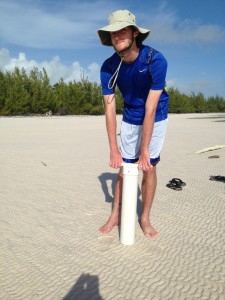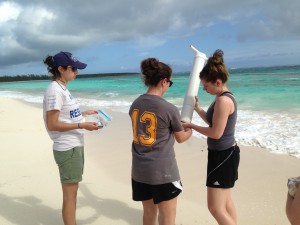PIPING PLOVER RESEARCHERS – THE NEXT GENERATION
CWFNJ AND MONMOUTH UNIVERSITY PARTNER IN THE BAHAMAS
By Todd Pover, Beach Nesting Bird Project Manager and Stephanie Egger, Wildlife Biologist

We totally shifted gears for the second half of our week here on Eleuthera, The Bahamas. Piping Plover surveys took a back seat as we focused on working with 20 students from Monmouth University (MU), who were taking part of in a two-week Tropical Island Ecology course during their winter break.
We settled into the Cape Eleuthera Institute, who hosted the students at their world class facilities for an intense (but fun) regimen of hands-on science research, typically marine based, but a Piping Plover unit was added for the MU students. It was particularly exciting to work with the MU students here in the Bahamas because back in New Jersey we have partnered with MU for over ten years on a beach nesting bird internship program during the summer months.
First up was an evening primer for the students on Piping Plovers, including a brief summary of our efforts in NJ on the breeding grounds and recent work by CWFNJ and others on the wintering grounds in the Bahamas. The next morning we were up early to kick off our trial research project; benthic macro-invertebrate sampling at Piping Plover wintering sites in the Bahamas to try to develop an inventory of their potential prey items, and eventually determine what constitutes a highly suitable foraging site. This was spurred, in part, by field observations of tidal flats that appear to be highly suitable, but have no piping plovers present, whereas similar adjacent flats are covered with shorebirds. Perhaps not all flats are created equal and prey availability is the key.

For our field work with the students we chose two sites in Eleuthera where Piping Plovers have been observed; Savannah Sound, a classic low-tide flat in a sheltered area, and Winding Bay, an oceanfront, high-energy beach. The students extracted core sediment samples (20 cm deep) at each site along prescribed transects (10 samples per transect) for two consecutive days. Then it was back to the lab to sift the sand, sort the samples, and identify any invertebrates found. As part of the analysis, the students compared the species abundance and diversity between the two different sites, as well as between different transects within a site.
The results are yet to come and this was just a preliminary test of the methods and logistics involved. We were learning along with the students and while we were happy with the overall outcome, many questions were raised that will have to be addressed if we decide to develop a larger more robust study moving forward. In the meantime, the students got to learn a bit about Piping Plovers in the context of a research project, and inaugurate what we hope is another long-term partnership in the Bahamas.

A special thanks to the staff at Cape Eleuthera Institute for their hospitality and for letting us be part of their innovative learning experience. Thanks to John Tiedemann and Pedram Daneshgar at Monmouth University for setting the wheels in motion and now helping us implement this partnership. And finally, “shout-out” to Taylor Rodenberg for stepping up to assist us with the field work – Taylor was one of our MU interns in New Jersey last summer and happened to be one of the students visiting the Bahamas this winter, so she is part of a small group of lucky people to see (and work with) Piping Plovers on both their breeding and wintering grounds!